As the global population grows and resources become scarcer, the need for efficient, sustainable farming on a worldwide basis has never been more critical, making IoT in agriculture initiatives a key focus of many farming operations. In this blog post, we’ll explore how the Internet of Things in agriculture is not just a growing phenomenon, but a true game-changer for modern farming.
From optimizing water usage to monitoring crop health, smart agriculture technology and smart farming technologies leverage connected devices to tackle some of the industry’s biggest challenges. By combining innovation with practicality, the Internet of Things in agriculture helps farmers boost yields, reduce costs, and make data-driven decisions that help feed the world. With connected technology becoming imperative for efficiency, now is an excellent time to explore how IoT in agriculture and IoT farming can reshape field operations and unlock new opportunities for agricultural success.
IoT in Agriculture
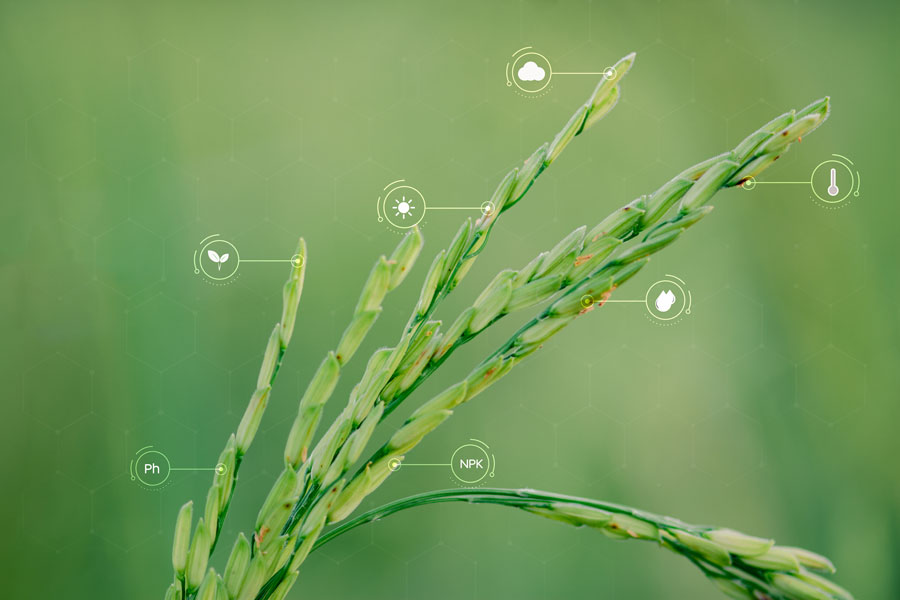 The rise of agricultural IoT has revolutionized farming, offering smart solutions that improve efficiency, sustainability, and productivity. IoT in agriculture connects sensors, drones, and machinery to automate remote processes and provide real-time insights into soil health, weather patterns, and crop conditions. These smart farming technologies help farmers monitor livestock, automate irrigation, track equipment to reduce waste and optimize resources, and more.
The rise of agricultural IoT has revolutionized farming, offering smart solutions that improve efficiency, sustainability, and productivity. IoT in agriculture connects sensors, drones, and machinery to automate remote processes and provide real-time insights into soil health, weather patterns, and crop conditions. These smart farming technologies help farmers monitor livestock, automate irrigation, track equipment to reduce waste and optimize resources, and more.
IoT in agriculture encompasses a broad range of activities — from precision farming that targets specific crop needs to supply-chain tracking to ensure food quality. By leveraging these smart agricultural technology, farms of all sizes can better position themselves for long-term success.
The Internet of Things and Agriculture
Thanks to IoT in agriculture, farmers can meet rising food demands using connected devices and real-time data. Today, farmers use nearly 100 million connected devices, and that number increases daily. Researchers estimate the global market for agriculture IoT solutions will exceed $33 billion by 2032, driven by the increasing adoption of precision farming and smart farming solutions. Here are a few examples of how agriculture IoT currently makes an impact:
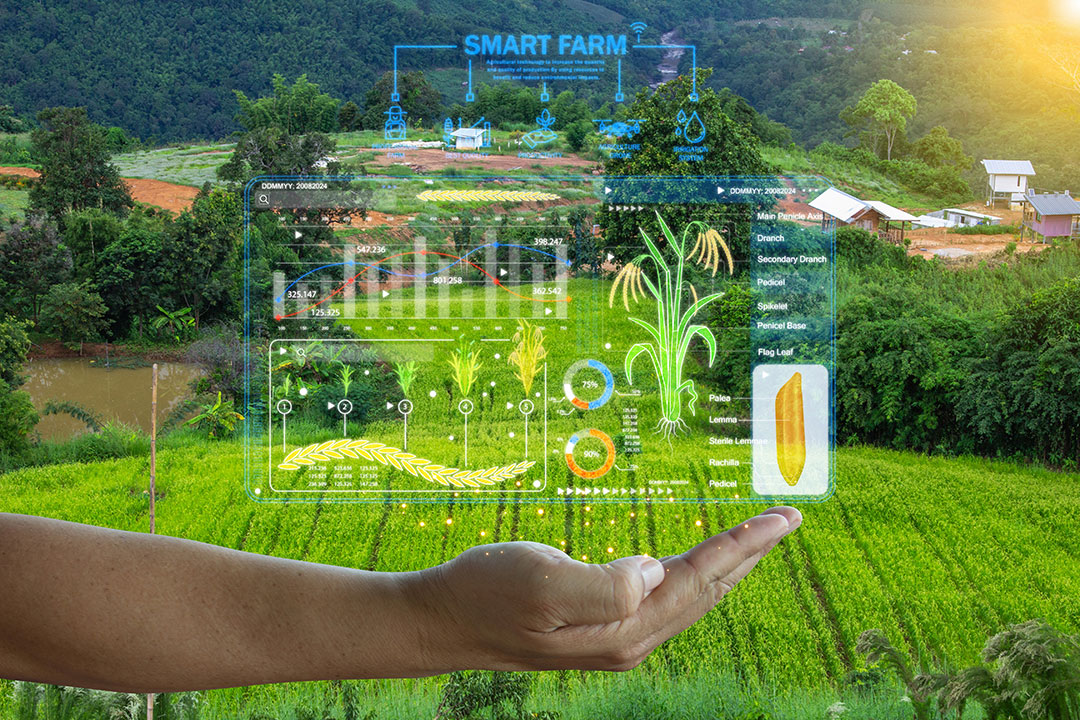
Benefits of Agriculture IoT
Smart farming technologies offer farmers a powerful toolkit to enhance efficiency, reduce waste, and increase profitability. Using IoT-enabled devices, IoT farming can monitor crop health, soil conditions, and weather patterns in real time, allowing for precise resource allocation and timely interventions.
Automated irrigation systems and equipment tracking reduce labor costs while improving accuracy. These smart farming technologies support sustainable practices by minimizing water usage and chemical inputs. Livestock monitoring solutions further ensure animal welfare and productivity.
With these benefits, IoT farming empowers agricultural producers to make data-driven decisions, ensuring higher yields and a more sustainable future.
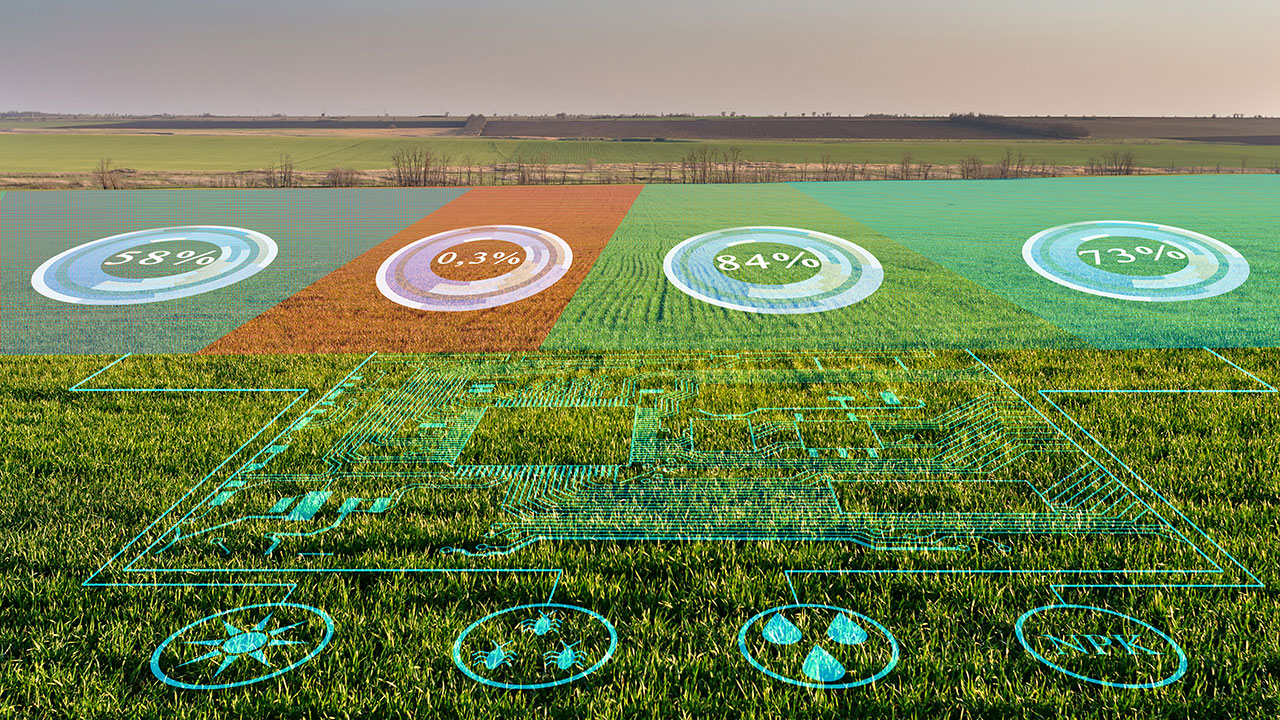
Yield Increases
The Internet of Things in agriculture enables farmers to achieve significant production gains through precise monitoring. Advanced tools monitor weather systems, track soil health, the effectiveness of feeding systems, plant growth, and environmental factors, enabling you to fine-tune your farming processes and maximize crop yields. The integration of the Internet of Things and agriculture ensures farmers can optimize every stage of production.
Resource Optimization
The IoT in agriculture helps farmers use resources more efficiently. Agriculture IoT can provide insights into water usage, fertilizer needs, and energy consumption. With a smart farming system, irrigation and nutrient delivery are tailored to specific crops, while reducing waste and improving productivity.
Environmental Impact Reductions
Agriculture IoT plays a key role in promoting sustainable practices. With the right solutions, smart agriculture solutions reduce water consumption, minimize chemical runoff, and shrink carbon footprints. These advancements help protect ecosystems while supporting long-term farming viability.
Labor Reductions
 Smart farming technologies such as self-driving tractors, automated watering systems, and robotic harvesters, reduce the need for manual labor.
Smart farming technologies such as self-driving tractors, automated watering systems, and robotic harvesters, reduce the need for manual labor.
Real-time monitoring systems allow farmers to manage operations remotely from centralized and convenient locations, saving time and improving efficiency.
Food Security Improvements
The IoT in agriculture strengthens food safety and quality. Real-time temperature sensors and wireless networks improve supply-chain transparency and minimize food waste. From farm to table, agriculture IoT ensures that produce, beef, fish, poultry, and dairy remain fresh, traceable, and accessible, benefiting both farmers and consumers.
10 Use Cases for the Internet of Things in Agriculture
The adoption of IoT in agriculture unlocks an impressive array of practical applications that address challenges modern farmers face. From optimizing crop production to streamlining operations, agriculture IoT provides powerful tools to enhance productivity and reduce costs, while also improving sustainability. Here are 10 transformative use cases that highlight the potential of IoT technologies in farming.
 Precision Farming Agriculture
Precision Farming Agriculture
In precision agriculture, IoT sensors collect data on soil conditions, weather, and crop health, enabling farmers to pinpoint exactly where resources like water and fertilizer are needed — and not needed.
Integrating precision farming technology into crop, greenhouse and livestock management also helps to automate remote processes, such as irrigation systems, feeding systems, frost fans, temperature management systems in barns, and more.
This approach boosts productivity, reduces waste, and helps farms operate more sustainably, making it a cornerstone of modern agricultural practices.
Precision Pest Control
IoT agriculture devices monitor pest populations and environmental conditions to predict and prevent outbreaks before they harm crops. By deploying targeted pest control measures, farmers minimize chemical use and ensure healthier harvests, supporting both efficiency and environmental health.
Livestock Monitoring
The IoT in agriculture can include wearables that track livestock health, location, and activity levels in real time, alerting farmers to issues like illness or injury. With this data, farmers can optimize animal welfare and productivity while reducing veterinary costs and losses.
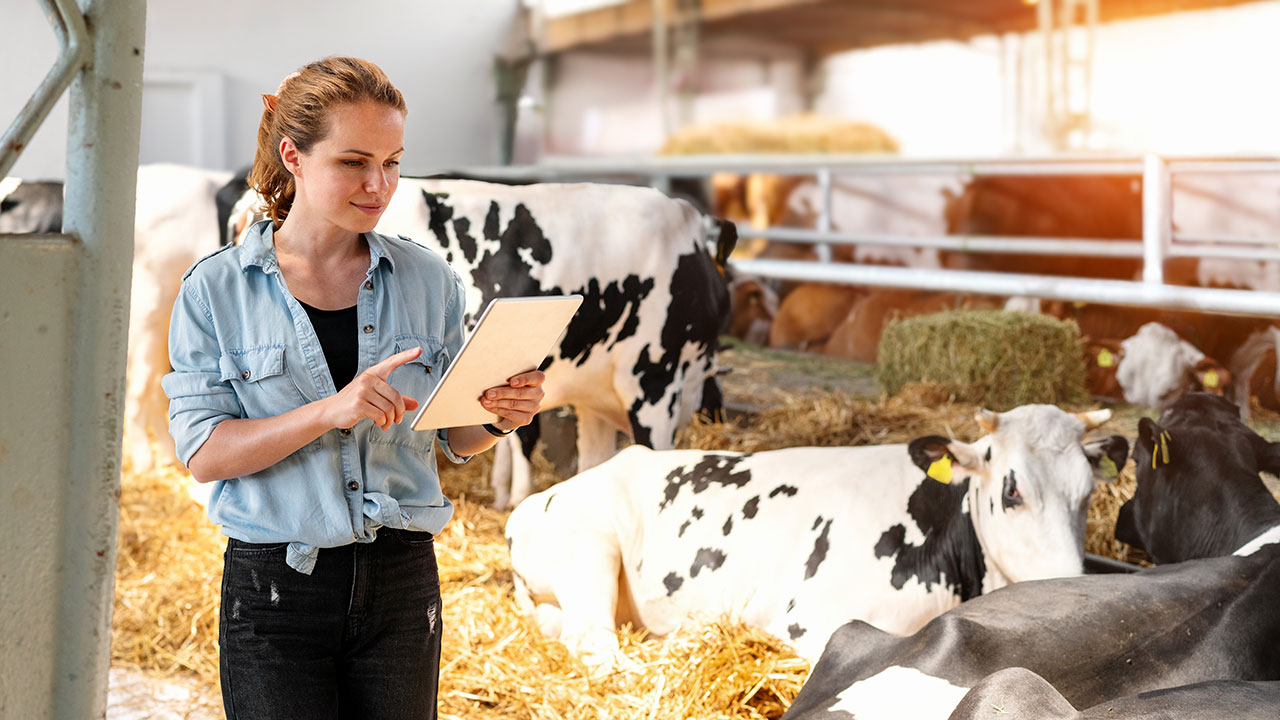
A smart farming system can include IoT-enabled sensors to collect weather-pattern, soil-moisture, and air-quality data to help farmers adapt to changing environmental conditions. These insights derived from smart agriculture technology enable proactive decision-making, protecting crops and improving resource usage.
Smart Greenhouses
 Smart greenhouses use IoT farming techniques to automate climate controls such as temperature, humidity, and lighting. By maintaining optimal growing conditions, IoT farming achieves higher yields with less energy and manual intervention. As a result, these solutions boost efficiency and sustainability.
Smart greenhouses use IoT farming techniques to automate climate controls such as temperature, humidity, and lighting. By maintaining optimal growing conditions, IoT farming achieves higher yields with less energy and manual intervention. As a result, these solutions boost efficiency and sustainability.
Farming automation systems are also prevalent in greenhouses and grow barns, including conveyors, irrigation systems, fertigation and robotics.
Smart Irrigation
 Smart irrigation systems ensure crops receive the right amount of water at the correct time, reducing waste and maximizing yield. These systems are a core component of smart farming solutions, helping conserve resources while improving crop performance.
Smart irrigation systems ensure crops receive the right amount of water at the correct time, reducing waste and maximizing yield. These systems are a core component of smart farming solutions, helping conserve resources while improving crop performance.
Since water management and conservation are a key concern for growers, smart irrigation is perhaps one of the most important precision farming agriculture applications today.
Embedded devices in irrigation pivot heads can connect to soil and moisture sensors, automate watering based on conditions, send sensor data to cloud applications for monitoring, alerts and remote management, and even support GPS for tracking the location of rolling irrigation systems to ensure they are properly located.
Yield Monitoring and Prediction
Smart farming technologies analyze historical and real-time data to provide insights into crop yields and other applications such as fish farm and shrimp farm management systems. The resulting information allows farmers to predict harvest sizes with greater accuracy. Further, the data helps optimize planting and fish pond management strategies and meet market demands effectively.
Farm Equipment Monitoring and Maintenance
IoT farming sensors monitor bins and tanks as well as machinery performance, and provide alerts when tank levels or temperatures are out of range, when malfunctions or inefficiencies occur or maintenance is required. By preventing equipment breakdowns, agriculture IoT solutions can reduce downtime and extend the lifespan of their tools, saving time and money.
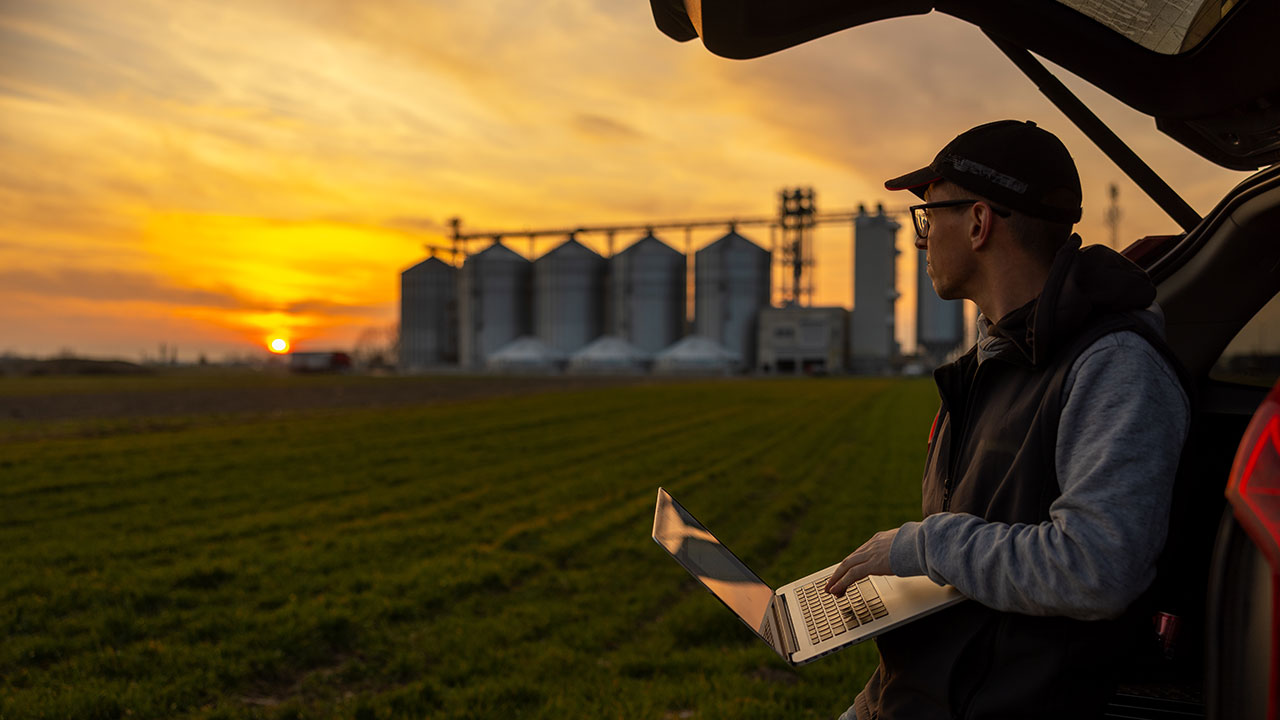
Remote Operations
IoT in agriculture enables farmers to control equipment, monitor fields, and access data remotely via smartphones, tablets, computers, or similar devices. This flexibility allows farms to operate more efficiently, even in remote or large-scale operations, enhancing productivity and convenience.
Supply Chain Optimization
Agriculture IoT devices can effectively track agricultural goods from farm to table, ensuring transparency and reducing spoilage. By streamlining logistics and improving traceability, the Internet of Things in agriculture supports food safety, quality, and efficiency throughout the agricultural supply chain.
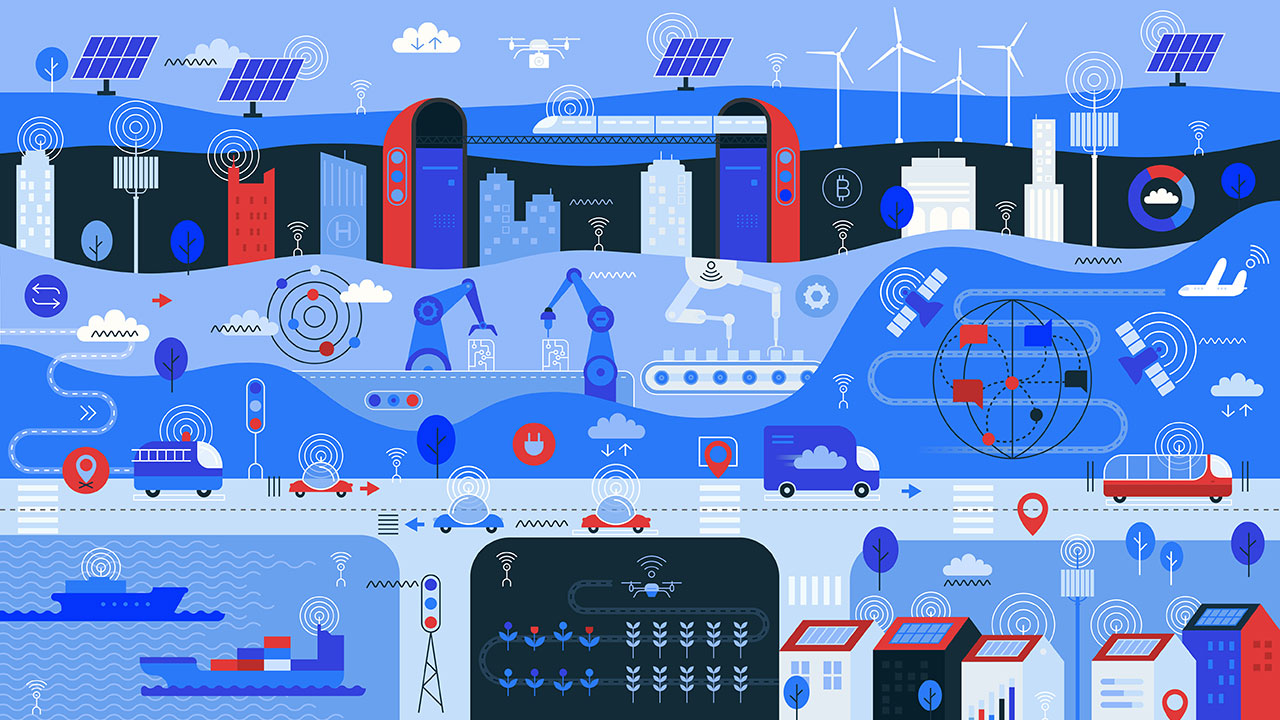
Smart Farming Technologies
Smart farming technologies encompass a wide range of tools that use IoT in agriculture. From drones and autonomous tractors to soil sensors and weather-monitoring systems, these innovations provide farmers with precise, actionable data to optimize every aspect of farming.
Central to agriculture and IoT, these smart farming technologies enable real-time monitoring, automation, and remote management of farms. By integrating AI, machine learning, and big data analytics, the agriculture Internet of Things helps farmers enhance efficiency, reduce waste, and improve sustainability. Whether it's automating irrigation or tracking livestock health, agriculture IoT solutions are paving the way for a more productive and environmentally friendly agricultural future.
Agriculture Robots and Automation
 Agricultural robots and automation are transforming farming operations by integrating smart agriculture technology to perform tasks with precision and efficiency.
Agricultural robots and automation are transforming farming operations by integrating smart agriculture technology to perform tasks with precision and efficiency.
These systems, powered by IoT agriculture technologies, reduce labor demands, enhance productivity, and support sustainability. Equipped with sensors and real-time data processing, IoT farming streamlines daily operations while minimizing waste and costs. Applications include:
- Robotic harvesting: Speed up fruit and vegetable collection with less damage
- Weed-control robots: Target weeds precisely, reducing chemical usage and promoting crop stability and yield
- Drone planting: Distribute seeds efficiently in challenging terrain
- Automated milking systems: Improve dairy productivity and animal welfare
- Precision spraying drones: Minimize pesticide application and protect crops
- Autonomous tractors: Perform tilling and planting with high accuracy
- Remote navigation: Control machinery and monitor field operations from anywhere
Drones
 Drones have become an integral part of Internet of Things farming, offering unparalleled efficiency and insight into agricultural operations.
Drones have become an integral part of Internet of Things farming, offering unparalleled efficiency and insight into agricultural operations.
Equipped with advanced cameras and sensors, drones provide farmers with valuable data for informed decision-making. These smart agriculture solutions improve precision, save time, and reduce costs, enhancing overall productivity. Key drone use cases for IoT in agriculture include:
- Land imaging/surveying: Capture aerial data for detailed mapping and planning
- Soil monitoring: Identify variations in soil health for precise treatment
- Livestock movement/counting: Track animal locations to optimize management
- Crop health assessment: Detect diseases and stress early for targeted interventions
- Irrigation monitoring: Ensure the proper distribution of water across fields
- Pest detection: Spot infestations to reduce pesticide usage and crop damage
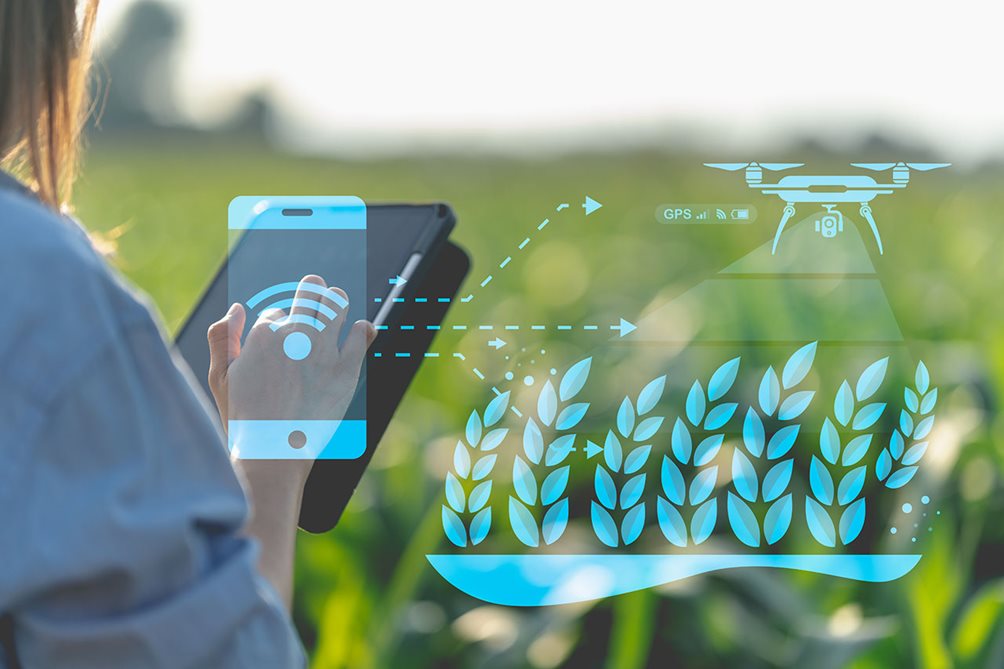
Remote Sensors
Remote sensors are essential in the integration of agriculture and IoT, enabling farmers to gather real-time data for more precise and efficient farming. These sensors monitor various environmental and operational factors, supporting better decision-making, resource conservation, and increased yields. From crop health to livestock management, agriculture sensors offer transformative benefits. Key use cases include:
- Crop monitoring: Track growth and detects early signs of disease or stress
- Weather/moisture: Monitor rainfall and humidity for optimized irrigation
- Soil quality: Measure nutrients and pH to guide fertilization strategies
- Livestock wearables: Monitor animal health and activity for improved welfare
- Irrigation efficiency: Identify areas needing water to reduce waste
- Greenhouse management: Regulate temperature and light for ideal growing conditions
Challenges with IoT in Agriculture
The integration of IoT in farming has revolutionized agriculture, but it also comes with notable challenges that can hinder widespread adoption. While agriculture IoT solutions offer immense benefits, farmers must address these obstacles to fully leverage the potential of Internet of Things farming. Understanding these challenges is essential for planning effective implementation strategies.
Rural or remote Internet connectivity is one primary barrier. Many farms are located in areas with limited or unreliable Internet access, which restricts the ability of IoT farming devices to collect and transmit data in real time. Without consistent connectivity, the efficiency and effectiveness of smart agriculture technology is compromised, slowing adoption in rural areas.
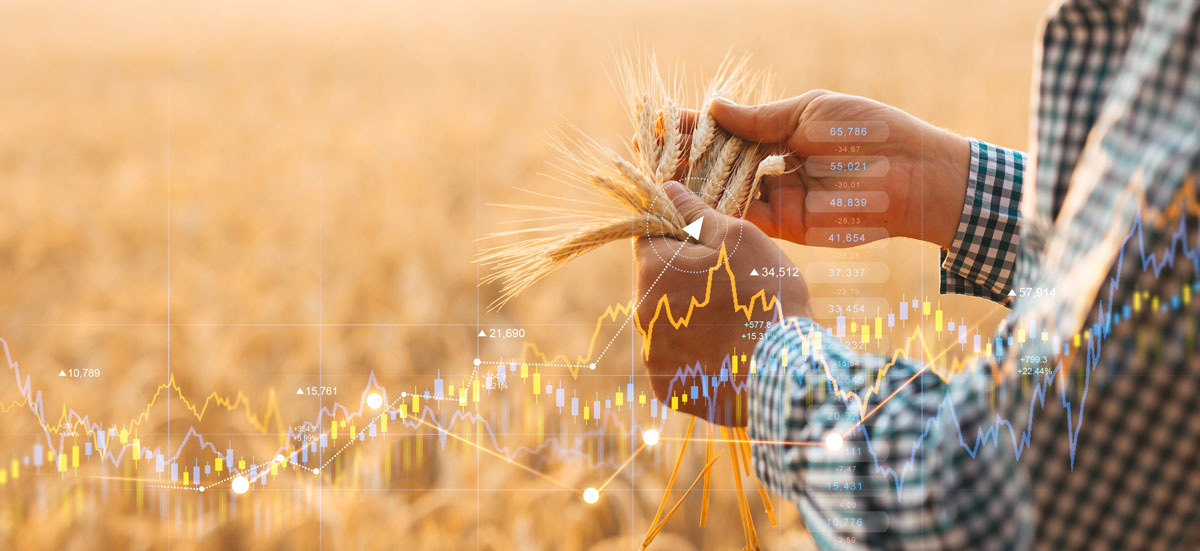 Collecting, storing, securing, and analyzing data presents another significant challenge. The sheer volume of data generation through agriculture IoT devices requires edge computing capabilities, robust storage solutions and advanced analytics. Ensuring data security is critical, since breaches could expose sensitive operational information or compromise system functionality. Farmers often need specialized support to make sense of complex datasets and translate insights into actionable decisions.
Collecting, storing, securing, and analyzing data presents another significant challenge. The sheer volume of data generation through agriculture IoT devices requires edge computing capabilities, robust storage solutions and advanced analytics. Ensuring data security is critical, since breaches could expose sensitive operational information or compromise system functionality. Farmers often need specialized support to make sense of complex datasets and translate insights into actionable decisions.
For IoT in agriculture, hardware and infrastructure set-up and scaling also pose hurdles. Initial installation of agri-IoT devices and supporting infrastructure can be costly and complex, particularly for small or mid-sized farms. Scaling these systems to meet growing demands requires careful planning and substantial investment.
Agriculture IoT Solutions
Digi’s innovative products and services enable ag operations to leverage the Internet of Things in agriculture, empowering farmers to overcome challenges and maximize efficiency. By enabling integration of advanced smart farming technologies like remote sensor connectivity, farming automation, and data-driven analytics, Digi's connectivity solutions make a real difference in driving efficiency, critical insights and cost reduction in modern agriculture. These agriculture IoT solutions simplify decision-making, conserve resources, and boost productivity while addressing critical issues like connectivity and scalability.
Digi's connected technologies help farms of all sizes deploy cutting-edge agriculture IoT solutions tailored to their needs. With Digi, farmers can obtain the technology and support needed to thrive in an increasingly competitive and resource-conscious agricultural landscape.
Digi Solutions for Smart Farming Systems
Digi offers a breadth of solutions to address the key challenges and goals of smart farming systems, such as wireless connectivity for remote areas, sensor connectivity to bring edge data to decision makers, and the connected technologies that enable process automation. These smart farming technologies enable seamless communication among IoT farming devices, ensuring reliable monitoring and control of operations like irrigation, livestock tracking, and equipment management.
Digi XBee RF and Cellular Solutions
 Digi XBee RF modules support a range of protocols including Zigbee®, DigiMesh®, Bluetooth®, 900MHz and 802.15.4. With pin-compatible footprints, this versatile line of easy-to-integrate modules supports both long-range and short-range smart farming applications, including tank monitoring, irrigation automation, weather and soil monitoring, and more.
Digi XBee RF modules support a range of protocols including Zigbee®, DigiMesh®, Bluetooth®, 900MHz and 802.15.4. With pin-compatible footprints, this versatile line of easy-to-integrate modules supports both long-range and short-range smart farming applications, including tank monitoring, irrigation automation, weather and soil monitoring, and more.
 Digi XBee Cellular modems include LTE Cat 1, Cat 4, and a combined LTE-M/NB-IoT modem, supporting a wide range of LPWAN applications. In agriculture IoT, these include water and temperature level monitoring, livestock feed bin monitoring, environmental monitoring for grow barns, livestock barns, greenhouses and more.
Digi XBee Cellular modems include LTE Cat 1, Cat 4, and a combined LTE-M/NB-IoT modem, supporting a wide range of LPWAN applications. In agriculture IoT, these include water and temperature level monitoring, livestock feed bin monitoring, environmental monitoring for grow barns, livestock barns, greenhouses and more.
This full suite of solutions is designed to help developers and OEMs in smart agriculture and other demanding environments to rapidly design, deploy and manage robust scalable networks of connected devices across low power wide area networks.
To see a broad range of XBee applications at work, visit our Customer Stories page, and filter by Digi XBee.
The Digi X-ON Solution
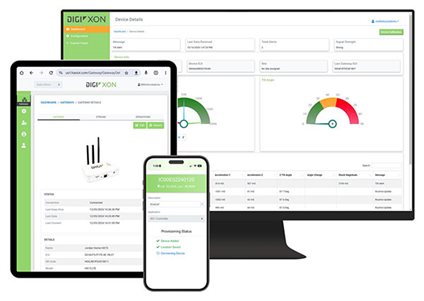
Digi X-ON® is a complete, secure, reliable edge-to-cloud IIoT solution for scalable deployments in widely dispersed networks. This makes it an excellent choice for agricultural applications like livestock monitoring, such as ear tags on herds of cows and sheep that track location, health and other metrics.
Fully integrated and ready to deploy, the Digi X-ON solution is designed for rapid rollout and fast ROI for a range of applications including precision agriculture, water management and industrial monitoring and control.
Digi ConnectCore SOM, Cloud and Security Solutions
 Digi ConnectCore® is a full suite of embedded modules, tools, development kits and services, designed to simplify and accelerate the development, deployment and management of secure, connected devices that can be managed and updated throughout their lifecycle.
Digi ConnectCore® is a full suite of embedded modules, tools, development kits and services, designed to simplify and accelerate the development, deployment and management of secure, connected devices that can be managed and updated throughout their lifecycle.
The Digi ConnectCore ecosystem offers all the building blocks for rapid design and development of connected products such as agricultural robots and farming automation equipment.
The suite includes Digi ConnectCore system-on-modules, integrated software, security and development tools, as well as Digi ConnectCore Security Services for security monitoring and reporting, and Digi ConnectCore Cloud Services for remote management.
Digi Cellular Router Solutions
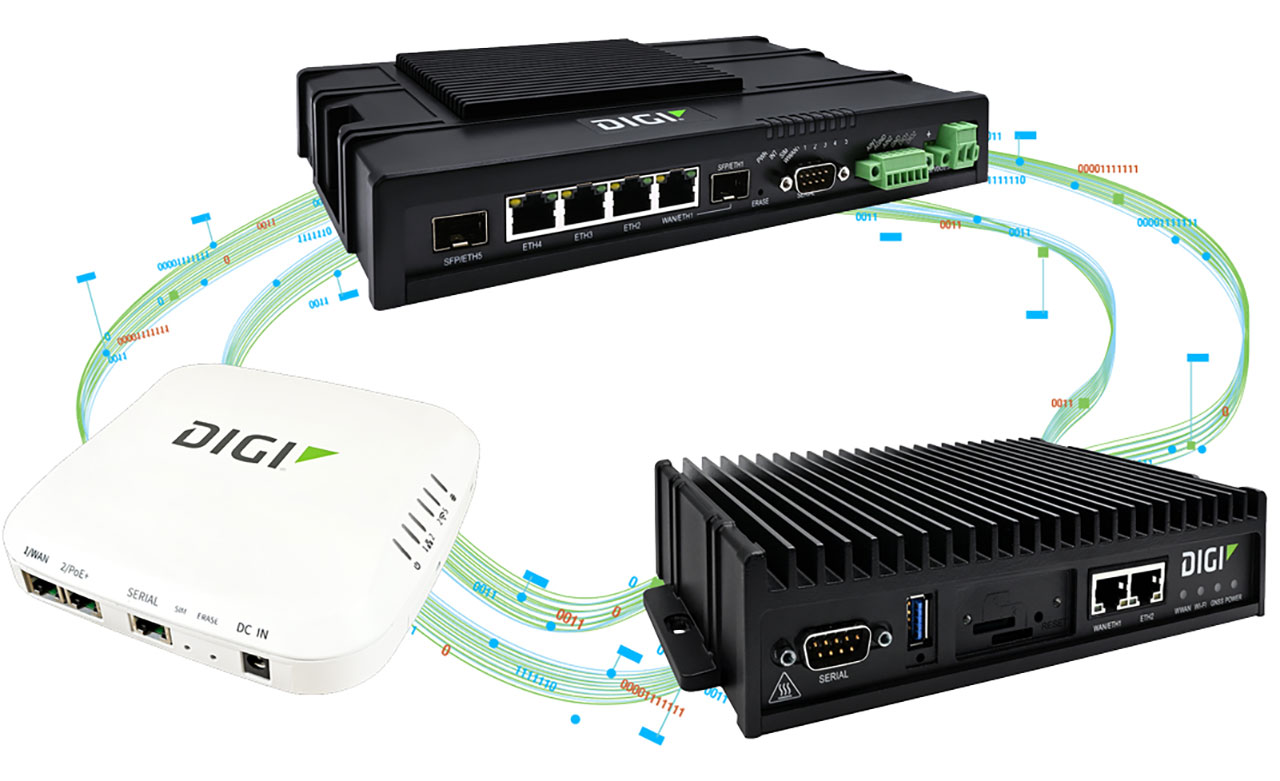
Digi’s suite of router solutions include enterprise, industrial and transportation routers. These are complete Digi 360 solutions, which means they come with the device, integrated remote management services, expert support and an industry-leading warranty.
Digi’s industrial cellular router solutions, in particular, support a range of agricultural applications, such a virtual fencing, farming automation, and barn and livestock monitoring.
Digi Infrastructure Management Solutions
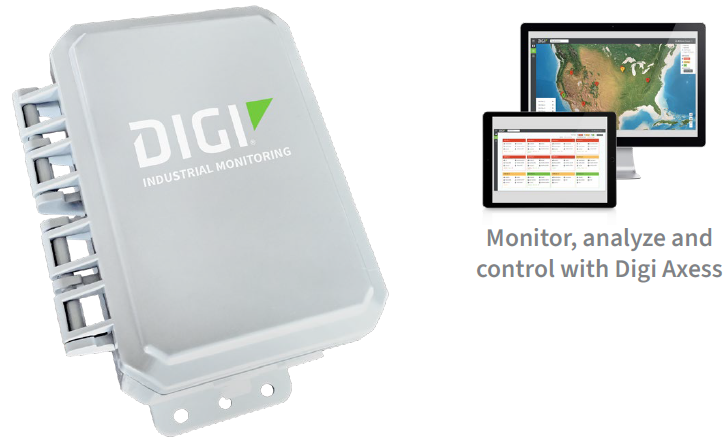 Digi’s solution suite under the Infrastructure Management umbrella include:
Digi’s solution suite under the Infrastructure Management umbrella include:
- Sensor gateways: Digi Connect® Sensor XRT-M with Digi Axess is a rugged, battery-powered remote monitoring solution. With rapid setup, it enables farmers to remotely collect and analyze data in minutes — supporting a range of applications, from tracking grain bin levels to monitoring soil conditions — even in power-limited environments.
- Serial servers: Digi Connect® EZ serial port servers provide connectivity for RS-232/422/485 configurations for farm automation systems, from irrigation controllers to climate monitoring equipment, to automated feeding systems. These complete LifeCycle Assurance solutions include the device, integrated remote management services, expert support and a best-in-class warranty.
- Industrial controllers: The Digi Z45 industrial controller, with Digi Axess, is an all-in-one automation solution that combines the functions of a PLC and SCADA system. This solution supports applications such as greenhouse climate control, irrigation automation, and livestock monitoring.
Remote Management Software
Digi Remote Manager® (Digi RM) simplifies the complexities of overseeing the IoT in agriculture by providing centralized control and monitoring capabilities. Digi RM addresses challenges like managing widespread devices, ensuring firmware updates, and troubleshooting connectivity issues.
Farmers can monitor operations, adjust settings or watering schedules, and resolve problems remotely, saving time and reducing on-site labor. With real-time insights and streamlined device management, Digi’s software ensures efficiency, reliability, and scalability to leverage the Internet of Things in agriculture in farming operations of any size.
Secure, Energy-Efficient Sensors and Devices
Digi IoT and M2M solutions support secure connectivity for sensors and devices across the IoT farming landscape — from farming automation to livestock management, bin monitoring and more. With a range of wireless, low-power and battery-operated agriculture IoT solutions designed for reliable, long-lasting performance in the toughest environments, Digi helps farming operations perform continuous monitoring of soil, crops, and livestock without frequent maintenance or battery replacements, for sustainable, cost-effective operations with minimal disruptions.
Digi also offers supporting services:
- Digi Wireless Design Services is a team of expert engineers that can help farming operations design their own solutions, or support developers and OEMs who want to build solutions to solve the challenges of farming customers. This team can provide assistance at any point along the way from prototyping to developing, testing, certifications, and helping to get products to market rapidly.
- Digi Professional Services is an expert engineering team that provides a range of application development, Digi product training and deployment services to help teams successfully deploy Digi networking solutions.
To see Digi customer applications at work in farming , visit our Customer Stories page, and filter by Smart Agriculture.
By providing scalable, robust connectivity options, Digi empowers farmers to implement efficient, data-driven practices using IoT in agriculture that enhance productivity, conserve resources, and improve overall farm management, even in the most challenging environments.
Reap the Harvest of IoT in Farming with Digi
Harnessing the power of IoT in farming is no longer a future vision—it’s today’s reality, and Digi is here to make it accessible. From advanced sensors and secure devices to robust connectivity and management software, Digi’s agriculture IoT solutions help farmers tackle challenges and optimize operations.
Whether improving yields, conserving resources, or enhancing sustainability, Digi solutions for IoT in agriculture equip you with the tools to succeed. Ready to revolutionize your farm? Explore Digi’s IoT solutions for agriculture or learn more about smart farming technologies today.
FAQs for IoT in Smart Farming
 Can IoT solutions from Digi International be used in all types of agriculture?
Can IoT solutions from Digi International be used in all types of agriculture?
Digi International's agriculture IoT solutions are versatile and can be tailored to various agricultural sectors, including crop farming, livestock management, and aquaculture, enhancing efficiency and productivity across diverse farming operations.
 impact environmental sustainability in agriculture?
impact environmental sustainability in agriculture?
By enabling precise resource management and real-time monitoring, Digi's smart agriculture solutions help reduce water usage, minimize chemical inputs, and lower carbon footprints, promoting environmentally sustainable farming practices.
 What types of sensors does Digi offer for agriculture IoT applications?
What types of sensors does Digi offer for agriculture IoT applications?
Digi offers a range of sensors to leverage the IoT in agriculture, such as soil-moisture sensors, weather stations, and livestock-tracking devices, providing comprehensive data to optimize farm management.
 How does Digi International ensure the security of agriculture IoT devices?
How does Digi International ensure the security of agriculture IoT devices?
Digi International ensures the security of agri-IoT devices through robust encryption protocols, secure data transmission, and regular firmware updates, safeguarding sensitive information and maintaining system integrity.
 How can farmers get started with Digi solutions to implement the IoT in agriculture?
How can farmers get started with Digi solutions to implement the IoT in agriculture?
Farmers can begin implementing Digi's smart agriculture technology by consulting with Digi's experts to assess their specific needs, selecting appropriate devices and integrating them into existing farm operations for enhanced management.
Next Steps